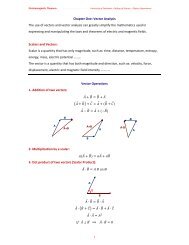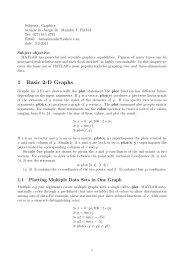Sentence Relations in the Writing of EFL Students at University Level
Sentence Relations in the Writing of EFL Students at University Level
Sentence Relations in the Writing of EFL Students at University Level
Create successful ePaper yourself
Turn your PDF publications into a flip-book with our unique Google optimized e-Paper software.
6.4 The Reliability <strong>of</strong> Scor<strong>in</strong>g<br />
Ellis (2003:349) st<strong>at</strong>es th<strong>at</strong> a test is reliable if it gives <strong>the</strong> same results<br />
when<br />
adm<strong>in</strong>istr<strong>at</strong>ed on different occasions or scored by different people.<br />
Thus, with<strong>in</strong> <strong>the</strong> concept <strong>of</strong> reliability <strong>the</strong> two types <strong>of</strong> consistency are<br />
<strong>in</strong>volved: <strong>the</strong> reliability <strong>of</strong> <strong>the</strong> test itself and <strong>the</strong> reliability <strong>of</strong> scor<strong>in</strong>g <strong>of</strong> <strong>the</strong><br />
test, referred to as test/re-test and mark-re-mark reliability respectively by<br />
(He<strong>at</strong>on 1988).For <strong>the</strong> purpose <strong>of</strong> <strong>the</strong> study, <strong>the</strong> reliability <strong>of</strong> <strong>the</strong> scor<strong>in</strong>g<br />
has been used. It is described as <strong>the</strong> consistency <strong>of</strong> scor<strong>in</strong>g by two or more<br />
exam<strong>in</strong>ers or <strong>the</strong> same exam<strong>in</strong>er on different occasions. From <strong>the</strong> sample<br />
<strong>of</strong> <strong>the</strong> study, fifteen test papers were randomly chosen. They were, <strong>the</strong>n,<br />
<strong>in</strong>dependently corrected by two scorers, <strong>the</strong> researcher and ano<strong>the</strong>r one<br />
(Mrs.Basima Othman) assistant <strong>in</strong>structor <strong>at</strong> <strong>the</strong> English Department, The<br />
two sets <strong>of</strong> scores were obta<strong>in</strong>ed and Pearson’s coefficient correl<strong>at</strong>ion was<br />
computed between <strong>the</strong>m. Reliability coefficient was (0.91) which<br />
Valette(1967:32)considers a high positive correl<strong>at</strong>ion.<br />
6.5 The Test Adm<strong>in</strong>istr<strong>at</strong>ion<br />
The test was applied to one hundred fourth year students dur<strong>in</strong>g<br />
<strong>the</strong> first term <strong>of</strong> <strong>the</strong> academic year (2006-2007). On 9.1.2007, <strong>the</strong> test<br />
was adm<strong>in</strong>istered <strong>at</strong> <strong>the</strong> English Department <strong>of</strong> <strong>the</strong> College <strong>of</strong> Educ<strong>at</strong>ion<br />
for Human Sciences. On 10.1.2007, <strong>the</strong> same test was adm<strong>in</strong>istr<strong>at</strong>ed <strong>at</strong> <strong>the</strong><br />
English Department <strong>of</strong> <strong>the</strong> College <strong>of</strong> Languages. The test papers were<br />
distributed and <strong>the</strong> <strong>in</strong>structions were read. The students were told to<br />
answer, <strong>the</strong>n <strong>the</strong> test papers were collected and scored. The results are<br />
quantified, tabul<strong>at</strong>ed and presented <strong>in</strong> table (1).<br />
7. Results and Discussion<br />
7.1 The Identific<strong>at</strong>ion and Classific<strong>at</strong>ion <strong>of</strong> Errors:<br />
The total number <strong>of</strong> cohesive devices correct as well <strong>in</strong>correct, are<br />
counted <strong>in</strong> students’ compositions, as shown <strong>in</strong> (Table 1).Then students’<br />
errors are identified and ranked <strong>in</strong>to five c<strong>at</strong>egories (See Table 3). A look<br />
<strong>at</strong> Table 3- shows th<strong>at</strong> <strong>the</strong> total number <strong>of</strong> <strong>the</strong> uses <strong>of</strong> reference is 279 and<br />
<strong>the</strong> number <strong>of</strong> <strong>in</strong>correct use is207 i.e. %40.27. Moreover, <strong>the</strong> total number<br />
<strong>of</strong> <strong>the</strong> uses <strong>of</strong> substitution is 11 and <strong>the</strong> number <strong>of</strong> <strong>in</strong>correct use is 5.i.e.<br />
%0.97, while <strong>the</strong> total number <strong>of</strong> <strong>the</strong> uses <strong>of</strong> ellipsis is 20 and <strong>the</strong> number<br />
<strong>of</strong> <strong>in</strong>correct use is 16 i.e. %3.11 <strong>of</strong> <strong>the</strong> uses are <strong>in</strong>correct. Fur<strong>the</strong>rmore, <strong>the</strong><br />
total number <strong>of</strong> <strong>the</strong> uses <strong>of</strong> conjunction is 260 and <strong>the</strong> number <strong>of</strong> <strong>in</strong>correct<br />
use is 205, i.e%.39.88.<strong>of</strong> <strong>the</strong> uses are <strong>in</strong>correct. F<strong>in</strong>ally, <strong>the</strong> total number <strong>of</strong><br />
<strong>the</strong> uses <strong>of</strong> lexical cohesion is 433and <strong>the</strong> number <strong>of</strong> <strong>in</strong>correct use is 81, i.e.<br />
%15.75. The st<strong>at</strong>istical analysis <strong>in</strong> table -8- shows th<strong>at</strong> <strong>the</strong> most frequent<br />
errors made by <strong>the</strong> sample are <strong>in</strong> <strong>the</strong> use <strong>of</strong> Reference. Reference takes <strong>the</strong><br />
first rank among o<strong>the</strong>r types <strong>of</strong> cohesive devices s<strong>in</strong>ce it forms % 40.27<strong>of</strong><br />
<strong>the</strong> errors. The errors <strong>in</strong> conjunction form %39.88 and take <strong>the</strong> second<br />
rank. While <strong>the</strong> errors <strong>in</strong> lexical take <strong>the</strong> third rank and form %15.75.The<br />
errors <strong>in</strong> ellipsis form%3.11and take <strong>the</strong> fourth rank whereas <strong>the</strong> errors <strong>of</strong><br />
substitution form %0.97 and take <strong>the</strong> fifth rank. Three types <strong>of</strong> st<strong>at</strong>istical<br />
comparisons are made <strong>in</strong> this chapter. First <strong>the</strong> two factors <strong>of</strong> cohesion,<br />
lexical and gramm<strong>at</strong>ical are compared with each o<strong>the</strong>r and presented <strong>in</strong> a<br />
separ<strong>at</strong>e table. The second type <strong>of</strong> comparison is performed among <strong>the</strong> four<br />
c<strong>at</strong>egories <strong>of</strong> correct, <strong>in</strong>correct gramm<strong>at</strong>ical devices. The third st<strong>at</strong>istical<br />
@@@@@@@@@@@Journal <strong>of</strong> Zankoy Sulaimani. Part B. No. 29 June 2010@ 216@

















